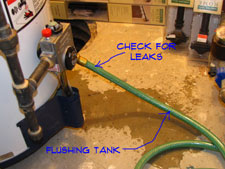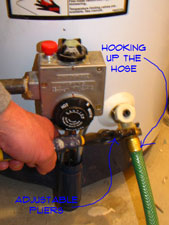 Knowing how to drain a water heater will make doing various repairs and maintenance items on your water tank much easier.
Knowing how to drain a water heater will make doing various repairs and maintenance items on your water tank much easier.
When would you need to drain your tank? A common task is 'removing sediment' and 'flushing the water tank'. Other tasks, such replacing an 'anode rod' or a 'dip tube' will require that the tank be partially or completely drained.
For related information, see 'Troubleshooting Electric Water Heaters' and
'Gas Hot Water Heater Troubleshooting'. These articles contain common problems and the resources to get them fixed.
You also have to drain the tank when you need to 'repair or replace the drain valve'. These valves are prone to leaking of often break when you attempt to tighten them.
With electric water heaters, the heating elements cannot be changed without draining the tank.
Shutting Down the Hot Water Tank
 You cannot drain a hot water tank while it is turned on. The heating elements and the tank can be damaged. Not to mention the danger in leaving a tank operational while you are working on it.
You cannot drain a hot water tank while it is turned on. The heating elements and the tank can be damaged. Not to mention the danger in leaving a tank operational while you are working on it.
The first step will be shutting down the hot water tank. This actually involves a few steps and is different for gas and electric water heaters. The correct procedures for doing this are covered in the articles on 'Shutting Down an Electric Water Heater'
and 'How To Shut Off a Gas Water Heater'. Read this information before proceeding with any draining activities.
Part of the procedure for shutting down the water tank includes cooling the water. This is a safety precaution, the water inside your tank can be very hot and cause burns. It is best to 'cool off the water' prior to working on the tank.
Where Should the Hot Water be Drained To?
Assuming that you have followed the procedure for shutting down the water tank, the water inside the tank should be just warm. This will not damage drains or plumbing fixtures.
A floor drain is the ideal place to drain the water into. Locate a floor drain near your hot water tank.
If you do not have a floor drain, you can drain the water outside. Warm water should not damage concrete or grass. Find a suitable location to drain forty or fifty gallons of hot water to.
Hooking Up a Drain Hose
You will need a hose that is long enough to reach the drain or other location that you are going to drain the water to. The female end of the hose will hook up to the water heater drain valve. You should use a pair of pliers to get it on tight.
Stretch the hose out so that it will drain. The hose should be lower than the drain valve on the water heater. There won't be any pressure when you drain the tank. It will only be gravity that allows the tank to drain.
Allowing Air to Get Into the Water Tank
 If you followed the 'shut down procedure', you should have opened up a hot water faucet somewhere in the home. This will allow air to get into the tank when the water is draining.
If you followed the 'shut down procedure', you should have opened up a hot water faucet somewhere in the home. This will allow air to get into the tank when the water is draining.
Make sure that the faucet is open, (preferably somewhere above the hot water tank) prior to opening the drain valve. When you are certain that valve is open, you can open the drain valve.
Water heater drain valves do not get used very often, so you may need to use a pair of pliers. Some drain valves are made of plastic, so be careful when you attempt to open it. If you damage the valve, now would be a good time to replace it. See the article on 'replacing a water heater drain valve' for instructions on how to do this.
Draining the Hot Water Tank
It will take some time for all of the water to drain out of the tank. Most hot water heaters have between 40 and 60 gallons of water in them. This would also be a good time to 'flush your hot water tank', see this article for what to do.
Now you should be ready to make repairs or perform other maintenance on your hot water tank.

